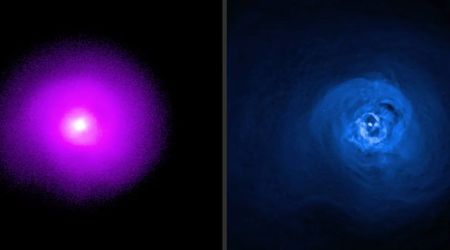New NASA Chandra image offers fresh insights into Andromeda galaxy

NASA's Chandra X-ray Observatory, in collaboration with other leading observatories, has released an unprecedented composite image of the Andromeda galaxy (M31), offering fresh insights into our closest spiral galactic neighbor. This new visual, compiled from a spectrum of light, also serves as a tribute to groundbreaking astronomer Vera Rubin, whose pivotal work on Andromeda revealed the first compelling evidence of dark matter, according to NASA.
This new image shows the Andromeda Galaxy in 5 different types of light — X-ray, UV, optical, infrared, and radio. Andromeda, also known as Messier 31 (M31), is the closest spiral galaxy to the Milky Way at a distance of about 2.5 million light-years. https://t.co/EdOhaXhGHb pic.twitter.com/j6MjeEo78w
— Chandra Observatory (@chandraxray) June 25, 2025
The newly released image integrates data across the electromagnetic spectrum, providing astronomers with a holistic understanding of M31's intricate structure and evolution. X-ray data from NASA's Chandra and the European Space Agency's XMM-Newton highlight high-energy phenomena, including emissions from the galaxy's central supermassive black hole and numerous compact objects scattered throughout.

Ultraviolet observations from NASA's retired GALEX, along with optical data from independent astrophotographers, contribute to a broader view of stellar populations and galactic morphology. Infrared data, sourced from instruments like NASA's Spitzer Space Telescope and ESA's Herschel, unveil cooler dust and gas regions, while radio data from the Westerbork Synthesis Radio Telescope maps out the distribution of neutral hydrogen.

The Andromeda galaxy has long been a cosmic laboratory for understanding the universe, particularly in the ongoing quest to decipher dark matter. Decades ago, Vera Rubin's meticulous observations of M31's rotational curves demonstrated that a significant amount of unseen matter was influencing the galaxy's dynamics — a discovery that laid the foundation for the concept of dark matter. This enigmatic substance remains one of astrophysics' most profound mysteries, a challenge NASA's forthcoming Nancy Grace Roman Space Telescope aims to address. In a direct acknowledgment of her monumental contributions, the United States Mint recently issued a quarter featuring Dr. Rubin as part of its 2025 American Women Quarters Program, marking the first time an astronomer has been honored in the series.

Accompanying the visual release is a unique sonification of the multi-wavelength data. This innovative auditory representation translates light into sound, with different wavelengths mapped to varying musical notes. As the sonification scans the galaxy from left to right, the intensity of light sources dictates volume, and vertical position influences pitch, allowing for an immersive and alternative way to experience the astronomical data.
📍 Andromeda Galaxy
— Hubble (@NASAHubble) August 30, 2024
➡️ 2.5 million light-years
🏠 Andromeda constellation
We’ve reached our final #MeetYourCosmicNeighbors destination: the Andromeda Galaxy! Hubble zoomed into its spiral arms, revealing swathes of ionized gas: https://t.co/2qcXGzUwms pic.twitter.com/kMmODcIVJ8
Managed by NASA's Marshall Space Flight Center, the Chandra X-ray Observatory continues to provide invaluable data. Recent Chandra observations of Andromeda's supermassive blackhole have documented its X-ray output over the past 15 years, including a notable flare in 2013 that represented a significant amplification of its typical activity. This comprehensive multi-wavelength approach to studying Andromeda not only deepens our understanding of this galactic neighbor but also offers critical insights into the evolution of our own Milky Way — a galaxy inherently more challenging to study from within.
The Andromeda galaxy, a majestic spiral residing approximately 2.5 million light-years away, isn't just a subject for astronomical study; it's also on a collision course with our own Milky Way. Current projections indicate that these two colossal galaxies will merge in several billion years from now. This cosmic event will culminate in the formation of a much larger, elliptical galaxy, within which the supermassive black holes currently anchoring both Andromeda and the Milky Way will eventually coalesce, according to NASA.









